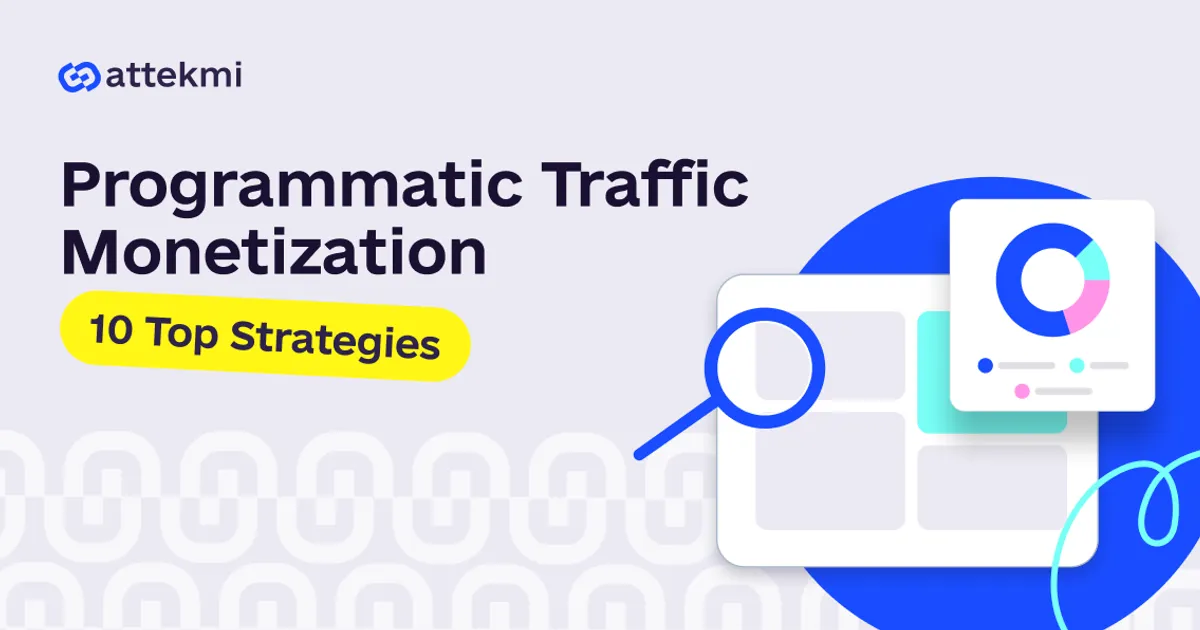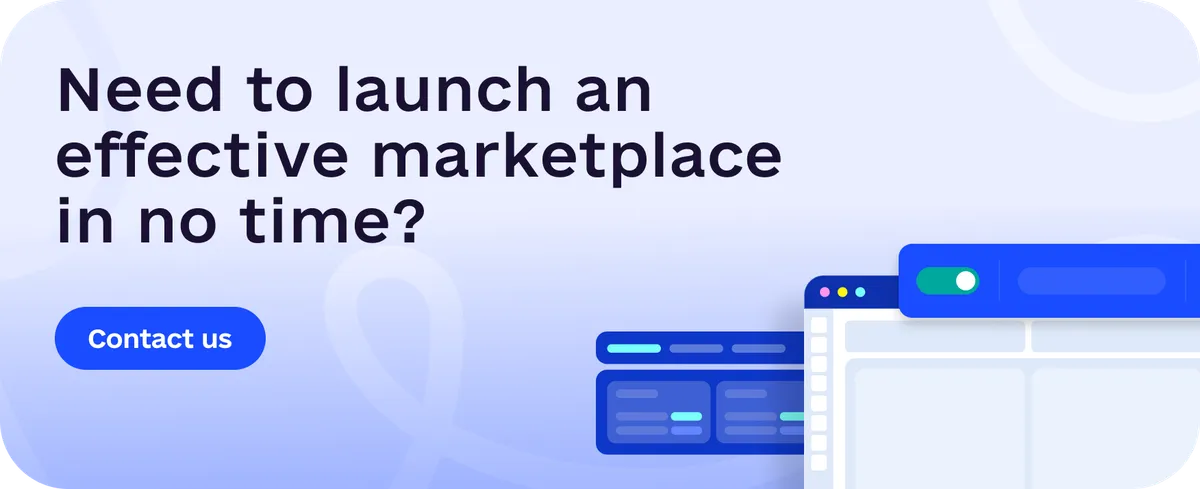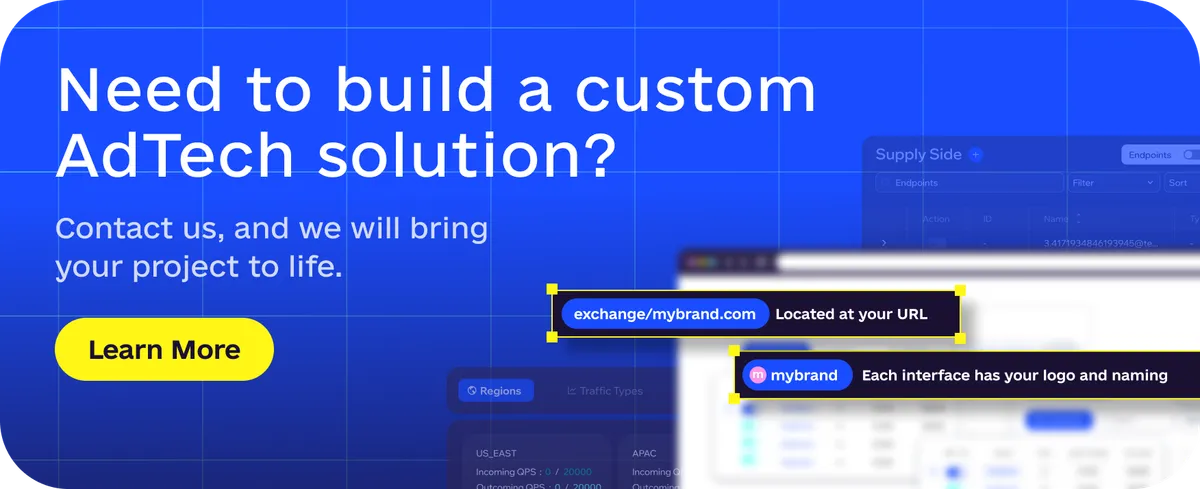For owners of websites and mobile apps, traffic monetization plays a crucial role, as it allows them to drive stable income.
Nowadays, programmatic advertising is the most effective way for publishers to monetize their traffic. It enables them to deliver targeted and relevant ads to their visitors and users, which improves their experience. Additionally, programmatic technology automates the process of buying and selling ad inventory, so that publishers can focus on their core tasks while their ad space will still be monetized – it is only essential to set everything up and monitor the performance.
One of the key programmatic advertising examples is mobile programmatic buying, which allows publishers to target mobile users with the same precision and efficiency. By leveraging this method, publishers can maximize their ad revenue on mobile apps and websites.
But what are the other benefits of programmatic advertising for traffic monetization? How to apply programmatic monetization effectively?
Since 2018, we have been empowering businesses to start earning on media trading by matching the right demand with the right supply. Relying on our extensive knowledge of both the demand and supply sides, we have prepared a guide answering these and other questions. Keep reading to learn more and discover top traffic monetization strategies.
Key Takeaways
Traffic monetization refers to the process of generating revenue from website or app traffic. Apart from enabling media owners to drive income, traffic monetization allows providing website visitors or app users with additional free services.
Automation capabilities are among the key benefits of programmatic technology in terms of traffic monetization. Instead of searching for advertisers manually, publishers can sell their inventory in a quick and effective manner.
Increased efficiency, real-time optimization, and access to diverse ad formats contribute to the effectiveness of programmatic technology for publishers.
The key traffic monetization strategies include, but are not limited to, audience segmentation, ad placement optimization, A/B testing, ad quality assurance, and cross-device targeting.
Getting an ad exchange solution allows you to gain greater control over your operations. With Attekmi, you can launch such a platform in the shortest time possible.
What is traffic monetization?
Let’s figure out how online traffic monetization works.
Traffic monetization is the process of generating revenue from website or app traffic. Such income is of great importance for website owners and publishers. Monetization helps ensure financial sustainability for such sites and increases the amount of free services for regular users. Monetization also allows you to diversify the sources of income for the platform.
Furthermore, successful online traffic monetization grants website owners a competitive edge, allowing them to invest in marketing, technology, and user experience enhancements, positioning them favorably in the digital landscape.
Programmatic traffic monetization also enables websites to offer core services for free, such as search engines and social media, while covering operational costs through advertising revenue.
Lastly, it contributes significantly to the global economy by supporting businesses within the advertising industry, creating jobs, and stimulating economic growth. In essence, traffic monetization plays a multifaceted role in the digital ecosystem, ensuring financial stability, growth, and innovation for website owners and publishers.
Why programmatic advertising is key for traffic monetization
Programmatic technology plays a crucial role in terms of monetization due to the following reasons:
Automation capabilities accelerate the process of media buying and selling
Access to a wide pool of advertisers
Higher fill rates and revenue
Improved user experience thanks to precise targeting
Enhanced scalability
Performance tracking
Diverse models: real-time bidding, header bidding, programmatic guaranteed deals, etc.
Benefits of programmatic advertising in traffic monetization
Programmatic advertising has a huge number of benefits for all the parties involved: advertisers get the necessary ad space and audience, publishers get traffic monetization, and users get relevant ads (in case marketers apply the right targeting and filtering settings). Programmatic advertising allows real-time optimization of ad campaigns, precise targeting, and transparency of bidding processes. It makes it easy to scale campaigns, fight ad fraud, and find the best economic solutions for each side of the bidding process.
In the ecosystem of digital advertising, programmatic technology has become virtually a must to adopt. Programmatic ad spending keeps growing and is projected to reach almost $780 billion by 2028 (globally). Neglecting it means a missed opportunity for both publishers and marketers. Therefore, if you, as a publisher, have not started to use a supply-side platform (SSP) for selling your inventory, it is the right time to do this. In turn, advertisers need to leverage demand-side platforms (DSPs) to purchase relevant ad space.
Now that the traffic monetization meaning is clarified, let’s review the advantages of programmatic advertising in traffic monetization in detail.
Increased efficiency and automation
Programmatic advertising streamlines the process of ad placement and optimization. It automates ad buying, targeting, and bidding, allowing publishers to maximize revenue while minimizing manual labor. This efficiency results in better monetization of web traffic as it reduces the time and resources required to manage ad campaigns.
Real-time optimization
Programmatic advertising allows for real-time adjustments to ad campaigns. This means that ads can be optimized on the fly based on performance metrics like click-through rates, conversions, and engagement. Publishers can continuously fine-tune their ad strategies to maximize revenue and ensure that they are capitalizing on the most lucrative traffic sources.
Access to diverse ad formats
Programmatic advertising supports a wide range of ad formats, from display and video ads to native and interactive formats. This versatility enables publishers to diversify their monetization strategies and cater to various audience preferences, ensuring that traffic monetization is not limited to a single ad format.
Data-driven decision-making
Programmatic advertising provides access to extensive data analytics, enabling publishers to make informed decisions about their traffic monetization efforts. They can use data to understand user behavior, preferences, and top advertising trends, allowing for data-driven optimizations and strategies that maximize revenue.
Increased competition and revenue potential
With programmatic advertising, multiple advertisers bid for ad space in real-time auctions. This competition often leads to higher ad prices and increased revenue for publishers. This competitive environment benefits publishers looking to monetize their web traffic effectively.
Enhanced ad inventory management
Programmatic advertising systems assist in managing ad inventory more efficiently by ensuring that ad space is used effectively. It helps avoid ad wastage by allocating ad slots to the most relevant and high-paying advertisements, optimizing the overall traffic monetization strategy.
Best 10 strategies for traffic monetization with programmatic advertising
Strategy | What It Does | Why It Matters |
Audience segmentation | Categorizing the audience according to specific characteristics (e.g., demographics) | To ensure a greater user experience and engagement |
A/B testing and optimization | Testing ad placements, formats, etc. | To increase click-through rates and maximize ROI |
Data analytics and insights | Analyzing user behavior and campaign performance | To fine-tune the strategy and drive higher income |
Ad placement optimization | Identifying the most effective ad placements | To optimize the strategy and ensure an improved user experience |
Header bidding | Offering ad inventory to multiple demand sources at once | To increase competition and drive higher income |
Programmatic direct deals | Building direct relationships with advertisers | To enhance transparency and ensure stable income |
Dynamic creative optimization (DCO) | Personalizing ad creatives in real time | To drive greater engagement |
Ad quality assurance | Maintaining quality standards | To ensure an ultimate experience |
Cross-device targeting | Reaching users across multiple platforms | To broaden reach and monetization opportunities |
Mobile app monetization | Implementing app monetization tactics | To drive income via your mobile app |
So, how to monetize web traffic? Finding effective monetization tools for publishers and learning everything about their functionalities is not enough. To drive stable income and provide your users with relevant experiences, you need to apply a variety of strategies. Take a look at the recommendations below to discover how you can enhance your traffic monetization approach.
1. Audience segmentation
Harness programmatic’s sophisticated targeting features to categorize your audience by demographics, interests, and behavior. This ad monetisation strategy empowers you to serve highly pertinent ads to precise user segments, resulting in elevated engagement and improved conversion rates. Additionally, audience segmentation allows you to improve user or visitor experience in general, which means that they will be less likely to stop interacting with your website or app.
For instance, women are usually not interested in seeing ads promoting car parts – such advertisements are often more relevant for men. This way, even basic segmentation can be useful, but the more precise you are, the better.
2. A/B testing and optimization
Consistently perform A/B tests on ad creatives, formats, and messaging to pinpoint the most effective elements for your audience. Utilize the findings to fine-tune campaigns, enhancing click-through rates and maximizing return on investment (ROI). With A/B testing, your whole approach to traffic monetization will become more data-driven as you will not act blindly.
For example, you can test different ad placements and, as a result, discover the most effective and profitable of them. Prioritizing these placements will help you increase your income and deliver better experiences for your users.
3. Data analytics and insights
Leverage data analytics to acquire valuable insights into user behavior and campaign performance. By making data-driven decisions, you can fine-tune your targeting, bidding, and overall strategy, leading to enhanced monetization results. Otherwise, if you neglect to analyze the performance of the inventory, it will be virtually impossible for you to adjust your strategy in the right way. Combine A/B testing with thorough analysis to prevent this from happening.
For instance, after analyzing the fill rates, as well as the number of clicks and impressions, you can identify the least profitable ad placements and fine-tune your strategy to increase the profit they bring.
4. Ad placement optimization
Explore various ad placements within your website or app to identify the most impactful positions for increasing user engagement and ad revenue. Conduct tests with different formats, such as in-text, in-feed, or sidebar ads, to ascertain the most effective approach. Note that ad placement optimization is essential not only for driving revenue – the most effective placements are the ones that are the best for user experience. And if you keep delivering exceptional experience, users will be coming back for more.
For example, you may discover that in-text ads are more effective on your website than sidebars. Considering this, you may want to reduce the number of sidebars and deliver a higher number of in-text advertisements. Again, to implement the ad placement optimization strategy effectively, you can use both A/B testing and analytics insights.
5. Header bidding
Implement header bidding to increase competition among advertisers for your ad inventory. This can lead to higher CPMs (cost per thousand impressions) and increased revenue. For marketers, header bidding is also beneficial since it ensures a fairer and more transparent environment – it becomes easier for them to access premium inventory.
During header bidding, the inventory is offered to multiple demand sources simultaneously, and the highest bid gets the ad space. This model eliminates the inefficiencies of the waterfall approach where requests are sent in a predetermined order. For instance, the floor price is $1.70, and the bids during the header bidding auctions are $1.50, $2.70, $3.65, and $2.20. In this case, the winning bid is $3.65. However, in the case of the waterfall model, if the bids come in the order mentioned above, the winning bid will be $2.70, which means that you will miss an opportunity to earn $3.65. This bid will simply not get called.
6. Programmatic direct deals
Explore programmatic direct deals, where you negotiate with specific advertisers or agencies to secure premium ad placements and higher rates, ensuring predictable revenue streams. For example, if you identify an advertiser that delivers relevant experience to your users and brings you stable revenue, going for direct deals would be a wise step to take as this will ensure stable income, while users will definitely see relevant ads. For marketers, this model is beneficial as well since they know for sure where their ads will be displayed.
7. Dynamic creative optimization (DCO)
Utilize DCO to personalize ad creatives in real time based on user data, such as browsing history or location. Tailored ads often result in higher engagement and conversion rates, which is an advantage for both publishers and advertisers.
For example, DCO may change the headline and the main copy of the ad, ensuring a personalized experience for every user.
8. Ad quality assurance
Maintain ad quality standards to ensure a positive user experience. Regularly review and approve ads to prevent low-quality or irrelevant content from detracting from your site’s appeal. Besides, make sure to apply filtering settings of your supply-side platform to prevent irrelevant marketers from showing ads on your website. For instance, if you discover that a specific advertiser continuously delivers low-quality advertisements, you can add them to a blacklist.
9. Cross-device targeting
Implement cross-device targeting to reach users on various platforms, including desktop, mobile programmatic, and connected devices. This broadens your audience reach and monetization opportunities. In turn, marketers get higher chances for driving conversions.
For instance, if you have a website optimized for mobile devices (and it should be to be effective), offering ad inventory only for its desktop version means missed revenue opportunities.
10. Mobile app monetization
If you have a mobile app, explore programmatic advertising options tailored for in-app monetization. In-app ads can be highly lucrative, especially with tailored ad formats for mobile users. For example, delivering playable ads can be beneficial for both publishers and advertisers since this improves user experience and drives engagement.
Challenges in traffic monetization and how to overcome them
Common obstacles in programmatic traffic monetization efforts include ad blocking, low click-through rates, declining ad revenue, and increased competition. Here are practical solutions and strategies to overcome these challenges in order to monetize traffic.
Ad-blocking
Many users employ ad-blockers to eliminate ads, reducing ad impressions and revenue. To address this, consider:
Educating Users: Explain the importance of ads in supporting free content.
Acceptable Ads: Adhere to acceptable ad standards to reduce user hostility.
Diversify Revenue: Explore alternative revenue sources beyond display ads.
Low click-through rates (CTR)
Low CTR can result in reduced ad revenue. To improve CTR, try:
Ad Placement: Optimize ad placement for better visibility and relevance.
A/B Testing: Experiment with ad creatives, formats, and calls to action.
Targeting: Refine audience targeting to match user interests.
Declining ad revenue
Economic factors or market shifts can lead to declining ad revenue. Solutions include:
Diversification: Explore various monetization methods, such as affiliate marketing, sponsored content, or subscriptions.
Ad Networks: Partner with multiple ad networks for a broader range of advertisers.
Audience Growth: For effective monetization, website traffic should be increased to attract more advertisers.
Increased competition
Rising competition can drive ad rates down. To address this:
Premium Content: Create premium, high-quality content to attract premium advertisers.
Private Marketplace (PMP): Join private ad marketplaces for access to exclusive, high-value ads.
Negotiation Skills: Hone negotiation skills to secure better deals with advertisers.
Ad viewability
Ads that aren’t viewed do not generate revenue. Strategies to improve viewability include:
Responsive Design: Ensure your website is mobile-friendly for better ad visibility.
Ad Positioning: Place ads where users are likely to see and engage with them.
Lazy Loading: Implement lazy loading to load ads only when they come into the user’s view.
Ad fraud
Ad fraud can result in wasted ad spend and decreased trust from advertisers. Combat ad fraud by:
Ad Verification: Use ad verification tools to detect and prevent fraudulent activity.
Bot Detection: Implement bot detection solutions to identify non-human traffic.
Third-Party Audits: Engage third-party auditors to verify ad performance.
Privacy regulations
Evolving privacy regulations can impact ad targeting. Strategies include:
Consent Management: Implement robust consent management systems for compliance.
Contextual Targeting: Shift to contextual targeting when user data is restricted.
User Education: Educate users about data collection and its benefits.
Ad quality
Poor-quality or irrelevant ads can harm user experience. Solutions involve:
Ad Review: Vet ads to ensure they meet quality standards and align with your content.
Quality Guidelines: Set clear quality guidelines for advertisers to follow.
Feedback Loop: Maintain open communication with advertisers for ad improvement.
Note that getting your own ad exchange solution provides you with greater control over your ad monetization strategy since you can match your supply-side platform (SSP) with the most relevant demand.
How Attekmi supports publishers in traffic monetization
At Attekmi, we offer a range of ad exchange solutions that is able to meet any needs:
AdEx Basic: An entry-level option with basic features.
AdEx Plus: An enhanced version of AdEx Basic.
AdEx Enterprise: A solution with advanced functionality and an ultimately scalable nature.
White Label Ad Exchange: A fully customizable platform, from UI personalization to custom on-request feature development.
As your trusted partner in any AdTech matter, we also provide the following services:
Custom AdTech development: We are ready to build your unique solution.
Ad Ops outstaffing: We can train an expert specifically for your business.
AdTech and Ad Ops team training: We are here to help you enhance your skills.
Supply-side platforms are the most common programmatic monetization solutions, and you will need one as well. However, launching your own ad exchange can boost your traffic monetization tactics and provide you with an opportunity to earn from media trading.
Check out the results our partners achieved:
Feeltapmedia created an ad exchange in 7 days, yielding 31% ROI and 28% revenue growth in 3 months;
Phonder skyrocketed its revenue by 87.47% and ramped up to 200K QPS in just one year;
Roqoon Media achieved a remarkable 262% revenue surge in just 3 months.
Does Attekmi look like the right choice? Contact us!
FAQ
Traffic monetization is the process of converting website or app traffic into revenue through various methods like advertising, affiliate marketing, or subscriptions. It is crucial because it provides financial sustenance for online platforms, supports the provision of free services, and diversifies revenue streams while contributing to the global economy.
There are several methods on how to monetize website traffic, like display advertising, affiliate marketing, sponsored content, subscriptions, and selling products or services. These approaches leverage your audience’s presence to generate revenue, making it essential to choose strategies that align with your website’s niche and target audience for optimal results.
Common mistakes to avoid in traffic monetization include overloading a website with ads, neglecting user experience, relying solely on a single monetization method, ignoring ad quality, and not adapting to changing market trends. Striking a balance between revenue generation and user satisfaction, diversifying income sources, and staying updated with industry shifts are essential for successful traffic monetization.
Effective traffic monetization can be achieved through various tools and platforms, such as Google AdSense for display ads, Amazon Associates for affiliate marketing, Taboola and Outbrain for native advertising, and AdMob for mobile app monetization. Additionally, content management systems like WordPress and e-commerce platforms like Shopify offer integrated traffic monetization solutions for website owners and publishers.
 By Iryna Kozirevych
By Iryna Kozirevych

